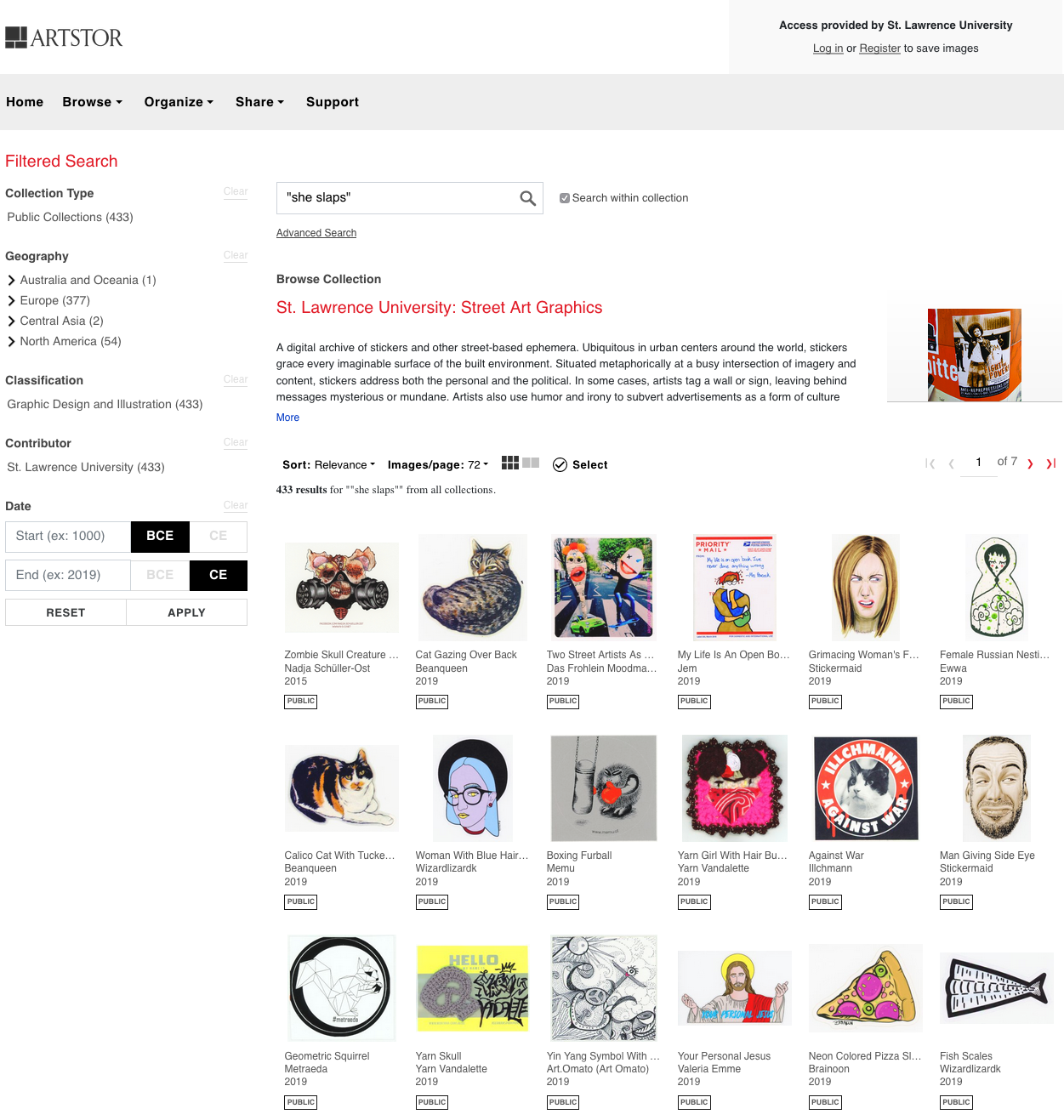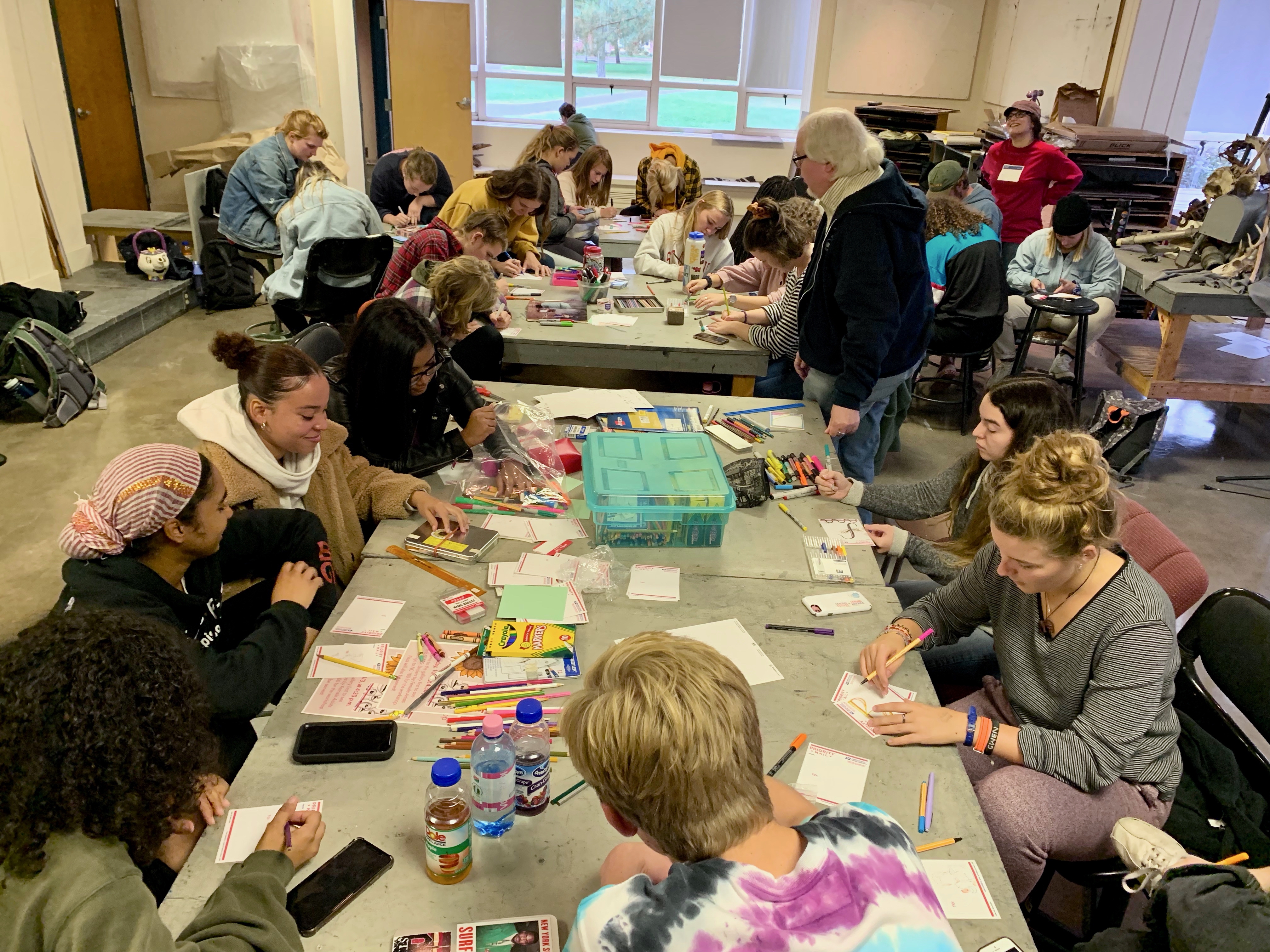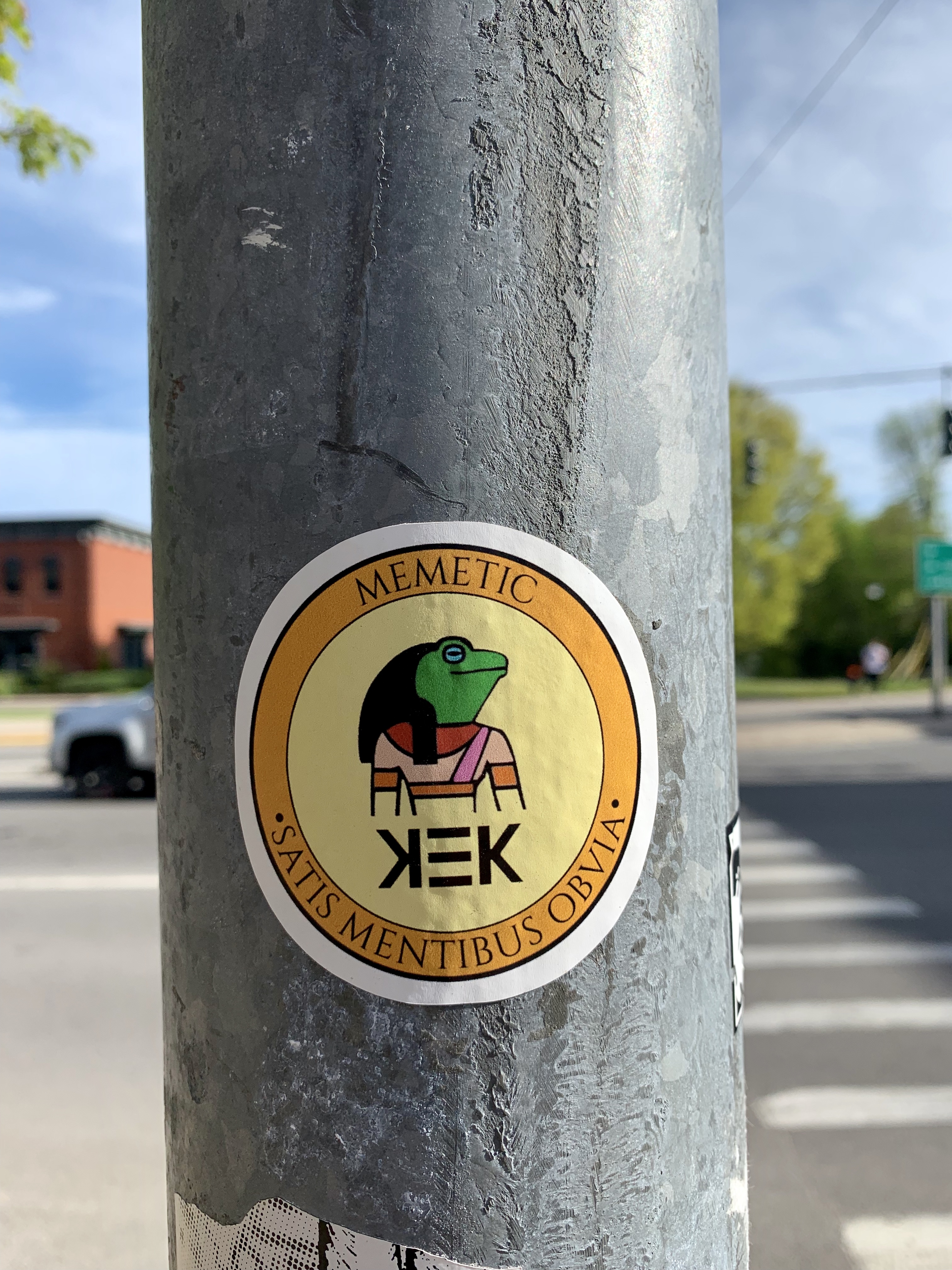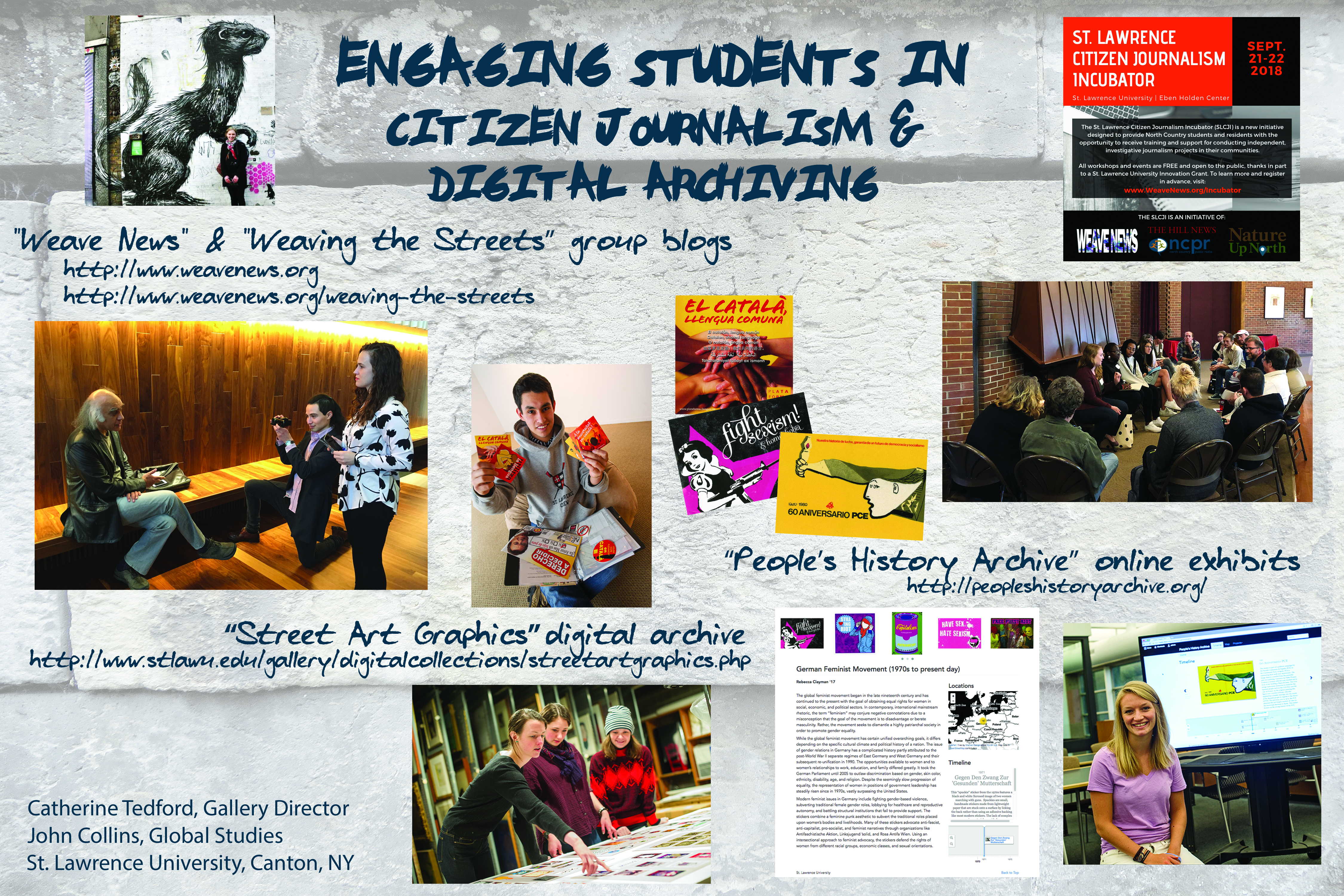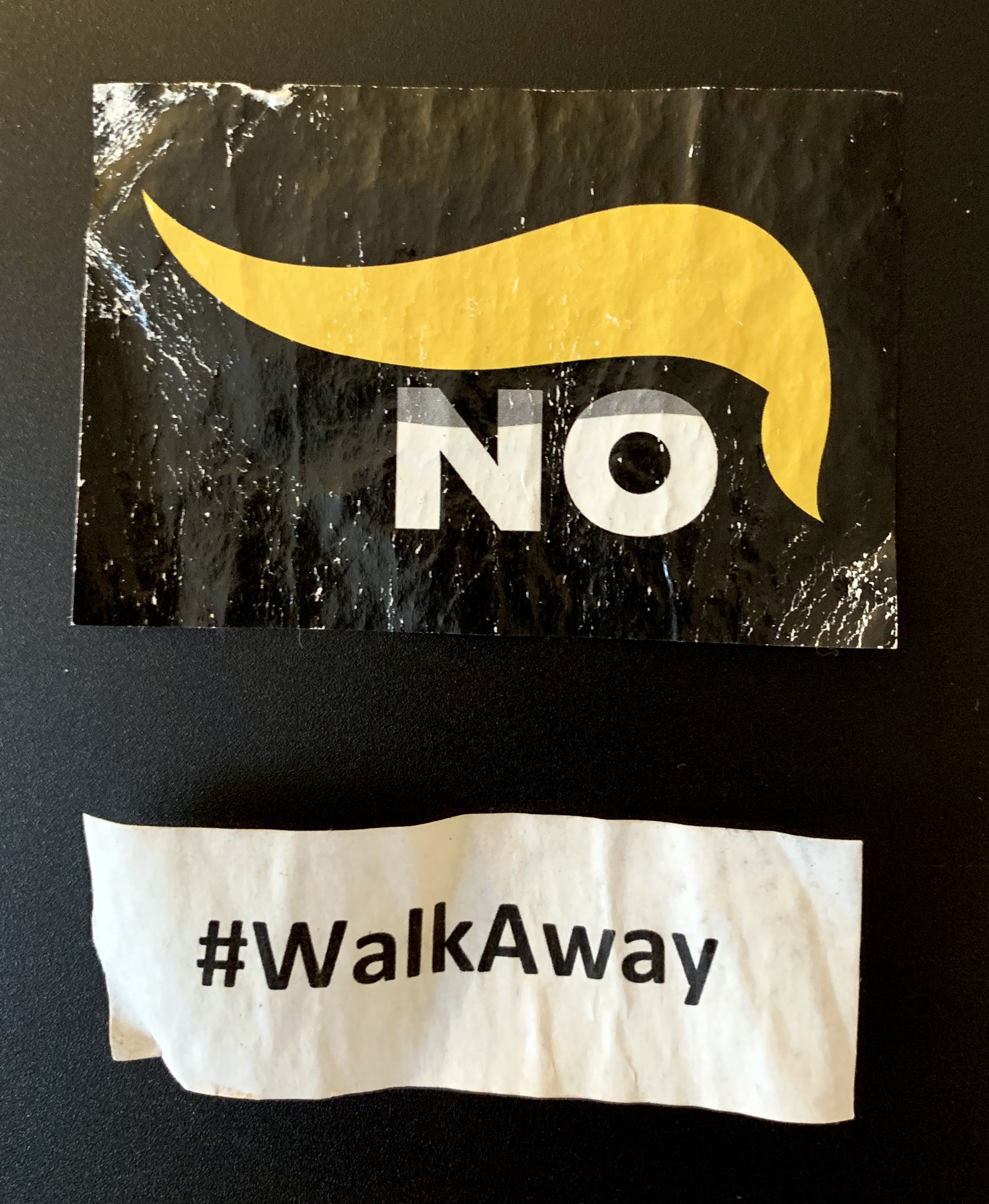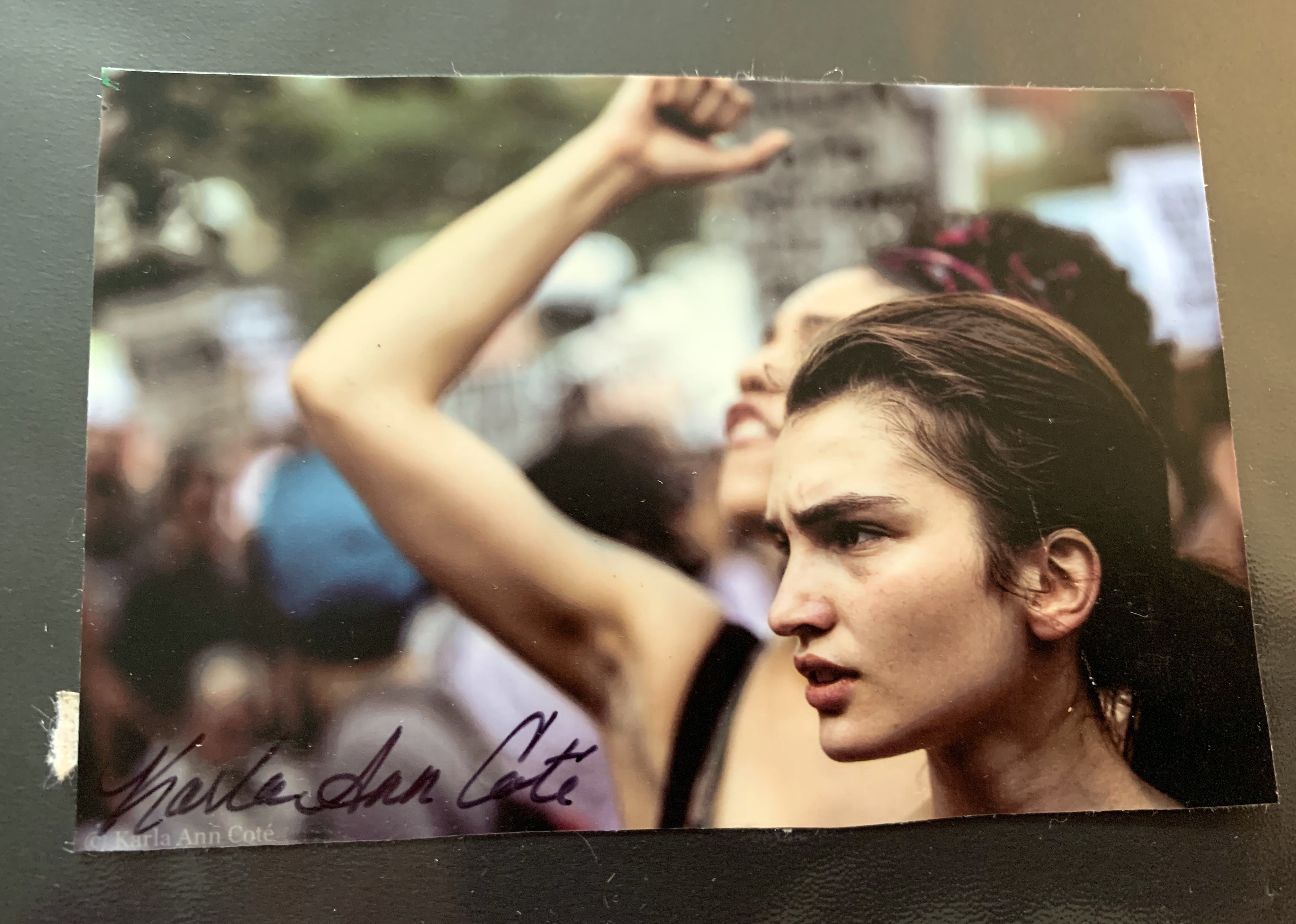In the fall of 2019, St. Lawrence University students in Dr. Brook Henkel’s German 103 class incorporated contemporary political stickers from Germany for a writing assignment, similar to what his students did in 2017 and in 2018. (Click on those two links for the actual writing assignment, preparatory readings, etc.). The work of two students, Stefan Dragićević ’22 and Sophie Lehmann ’20, is featured below. Thanks also to Brendan Reilly ’20 for the German-to-English translations.
Note: the right-wing NPD and Freiheit/Islamismus stickers pictured below were donated to me in 2017 by Irmela Mensah-Schramm, a 74-year old Berlin-based woman who has devoted much of her adult life to removing symbols of hate in Germany. NDP stands for Nationaldemokratische Partei Deutschlands or National Democratic Party of Germany.
Stefan Dragićević
Die Geister aus der Vergangenheit – The Spirits of the Past
Die größten Rivalitäten in der deutschen Politik sind seit den 1930er Jahren die Nationalisten und diejenigen, die den Nationalismus verurteilen. Nach dem Fall des Dritten Reiches wird der Nachfolger der NSDAP die NPD, die weiterhin Ideen verbreitet, die Nationalismus, Rassismus und Antisemitismus fördern. Aufgrund massiver Zuwanderungen aus dem nahen Osten und Unruhen in Europa haben die Nationalisten von der deutschen Bevölkerung mehr Unterstützung erhalten, da sie der Idee folgen: „Deutschland für Deutsche”. Andererseits galten die linken Parteien als der größte Feind des Nationalsozialismus. Sie fördern die Meinungsfreiheit und wollen Flüchtlingen helfen, sich in die deutsche Gesellschaft zu integrieren. Es gibt viele Grundschulen oder Kindergärten, die sich an Kinder aus dem Nahen Osten richten, in denen sie etwas über die deutsche Kultur und die deutsche Sprache lernen.
Since the 1930s, the grandest rivalries in the German political scene have been those between the nationalists and their opponents. After the fall of the Third Reich, the National Democratic Party became the successor party to the previous Nazi party, and continued to spread nationalist, racist, and anti-Semitic ideologies. Due to mass immigration from the Near East, as well as a general unrest in Europe, the NDP has gained increasing support from the German public, who follow their idea of keeping “Germany for Germans.” On the other side, the German left-wing parties have functioned as the greatest opponents to national socialism. These groups support freedom of opinion and want to assist the integration of incoming refugees into German society. There are many kindergartens and elementary schools that devote special attention to educating students from the Near East on German language and culture.

In der Mitte des Aufklebers, den ich beschrieben habe, befindet sich ein Satz, der in zwei Teile unterteilt ist: Im ersten Teil heißt es: „Geld für die Oma”, während im zweiten Teil heißt es: „Statt für Sinti und Roma“. Die beiden Teile der Sitzung sind in Gelb und Schwarz hervorgehoben. In Verbindung mit der roten, ovalen Form des NPD-Logos werden die Farben der deutschen Flagge dargestellt. Das mag naiv aussehen, aber es ist umstritten, ob es angebracht ist, deutsche Symbole in der Öffentlichkeit zu zeigen, da sie meist mit der Nazizeit in Verbindung gebracht werden. Im Hintergrund des Aufklebers ist eine alte Frau zu sehen, die verängstigt die Worte „Sinti & Roma“ ansieht. Sinti und Roma sind Menschen, die vom indischen Subkontinent abstammen, und sich vor Jahrhunderten in Europa niedergelassen haben. Während der Nazizeit haben sie zusammen mit der jüdischen Bevölkerung große Verluste erlitten. Darüber hinaus kann der Begriff Sinti und Roma als Pejorativ für Flüchtlinge aus Zentralasien und dem Nahen Osten verwendet werden, die ähnliche körperliche Merkmale aufweisen. Der Zweck des Aufklebers besteht darin, die Gefühle der Menschen hervorzurufen und sie auf eine schlechte finanzielle Lage der alten Bevölkerung aufmerksam zu machen, die von den ankommenden Flüchtlingen bermutlich verursacht würde.
In the middle of the first sticker is a sentence that has been divided into two parts: the first portion translates to “money for Grandma,” while the second translates to “instead of for Sinti and Roma.” Both sentences are emboldened with black and yellow highlights. Alongside the red, oval form of the NPD logo, the colors of the German flag are depicted. It remains controversial as to whether it is appropriate to fly the German flag in public, due to the lingering connection of German national symbols to the country’s Nazi past. In the background of the sticker is an old woman, looking worriedly at the words “Sinti and Roma.” Sinti and Roma are groups of people stemming from the Indian subcontinent, having settled in Europe over hundreds of years ago. During Nazi rule, these groups suffered great losses alongside the Jewish population. Since then, the terms Sinti and Roma have been used as pejoratives for refugees from Central Asia and the Near East, who bear similar physical characteristics to those of the Sinti and Roma. The goal of this sticker is to bring attention to the financial woes of Germany’s elder population, and to blame it on the arrival of refugees.

Der zweite Aufkleber steht für ein gelbes Verkehrszeichen, das in zwei gleiche Rechtecke unterteilt ist. Im oberen Rechteck steht „Freiheit“, im zweiten ein gekreuztes Wort „Islamismus“. Auch wenn es kein Party-Logo gibt, kommt dieses von einer rechten Partei, die die genetische und ethnische „Reinheit“ der Nation fördert, die sich erst kürzlich vereinigt hat!
The second sticker represents a yellow traffic sign, divided into two rectangles. In the top rectangle stands the word “freedom,” in the second the crossed-out word “Islam.” Even without a party logo, it is clear that this sticker was produced by a right-wing group that supports the genetic and ethnic “purity” that initially brought the German nation together.

Obwohl die Unterstützung der Rechtsextremisten in der Bevölkerung zugenommen hat, stimmt die Mehrheit der deutschen Bevölkerung nach wie vor zu, dass es, wie auf dem dritten Aufkleber geschrieben, “Kein Kiez für Nazis” geben sollte.
Despite the growth in support for the extremist right-wing parties in the German population, the majority still agrees that there is “no place for Nazis” (the original German phrase makes use of the word “Kiez,” a word for “neighborhood” that is specific to Berlin and other parts of Northern Germany).

Bevor die massiven Migrationswellen aus dem nahen Osten einsetzten, waren die rechten Parteien nicht sehr beliebt. Andererseits, wie auf dem Aufkleber zu sehen ist, nimmt die Popularität jener Parteien, insbesondere der AfD zu, die nur fünf Jahre nach ihrer Gründung massive Unterstützung von Deutschen erhalten haben, die in irgendeiner Weise die Bedeutung der deutschen Sprache unterstützen Reinheit. Es ist wichtig zu erwähnen, dass der Begriff ,,Reinheit“ die Ansicht vertritt, dass nordische und germanische Sprachen und Nationen im Vergleich zu anderen überlegen sind und über andere Nationen herrschen sollten. Obwohl es illegal ist, solche Ideen zu bewerben, wie auf den Aufklebern zu sehen, gibt es immer noch Anhänger der nationalsozialistischen Ideologie, die in den kommenden Jahren noch zunehmen werden.
Before the massive waves of immigration from the Near East, the right-wing parties in Germany had little support. However, as these stickers make clear, the popularity of these parties has grown—particularly for the AfD (Alternative for Germany), who have amassed a grand level of support in only five years after their conception. Like other right-wing parties, the AfD stands for the so-called “purity” in Germany. It is important to mention that the term “purity” is tied to Nordic and German languages and nations, and suggests that they are superior to others. Although it is illegal to advertise such ideas, posters and stickers with nationalistic messages and ideologies are ever present, and their number will only grow in the coming years.
Sophie Lehmann
Antifascist stickers from multiple languages
Die Aufkleber, die ich beschreiben will, befassen sich hauptsachlich mit dem Thema Antifaschismus. Der Antifaschismus hat in Deutschland eine historische und heutige Signifikanz, weil die rechtsextreme Politik in Europa seit dem 19. Jahrhundert ein laufendes Problem ist. Diese Bewegung wird noch wichtiger, weil das Land in der Vergangenheit eine faschistische Regierung erlebt hat. Das war in Deutschland der Fall, also sind die antifaschistischen Botschaften sehr direkt und kraftvoll. Bevor der zweite Weltkrieg begann, hatte es auch Probleme mit Rechtsextremismus gegeben. Rechtsextremismus verschwand nicht, nachdem die Nazis gefallen waren, das heißt, die Probleme sind nie verschwunden. Die Aufkleber, die ich ausgewählt habe, befassen sich mit Antifaschismus und benutzen auch andere Sprachen als Deutsch. Der Antifaschismus unterstützt eine Mischung aus Identitäten. Der Faschismus fördert normalerweise die Idee, dass es nur einen richtigen Weg zu sein gibt (Jackson).
The stickers that I’ll be describing deal mainly with antifascism. This movement has both a historical and a present significance in Germany, because the right-wing extremist politics have been an ongoing problem in Europe since the 19th century. The movement becomes particularly strong when a country that has experienced a fascist government in the past. Such is the case in Germany, and today the antifascist messages are very direct and powerful. Before the Second World War began, there had already been a problem with right-wing extremism. It did not disappear with the fall of the Nazis, either—such problems have never faded. The stickers that I’ve chosen follow a theme of antifascism and use German as well as other languages, as the movement is supported by a variety of identities. Contrarily, fascism tends to support the idea that there is only one true way to be (Jackson).

Ich habe diesen Aufkleber als Hauptaufkleber gewählt, weil ich der Text in italienisch und das Bild der Unruhen sehr relevant für die Diskussion über verschiedene Identitäten und Antifaschismus gefunden hat. Der Aufkleber ist rechteckig mit Rot und Schwarz als Hauptfarben. Das Bild enthält auch die Farben Weiß und Gelb. Im Vordergrund steht ein Text auf Italienisch im Weiß, der, wenn man das übersetzt heißt „Wir sind alle Antifaschisten.“ Im Hintergrund des Bildes ist die Farbpalette warm und dunkel. Die Farben sind von Feuer und Unruhen. Insgesamt erinnert das Bild der Unruhen und der Farbpalette an die neueste antifaschistische Aktion. Der Text in italienisch erinnert an historische antifaschistische Aktionen wie aus dem zweiten Weltkrieg, weil Italien auch in der Vergangenheit eine faschistische Regierung erlebt hat.
I’ve chosen these stickers, because I’ve found that its use of Italian and imagery of unrest are very relevant for the discussion of various identities and antifascism. The sticker is square with red and black and includes also white and yellow. In the foreground stands the Italian text in white, which translates to “we are all antifascists.” In the background is a color palette that is both warm and dark. The colors are those of fire and unrest. The image and its colors call to mind the recent antifascist action. The linguistic context also calls to mind Italy’s historical dealings with a fascist government.

Dieser Aufkleber mischt das französische Motto “Liberté, Égalité Fraternité” mit einer Anti-AFD-Nachricht. Weil Alternative für Deutschland eine relativ rechtsextreme Partei ist, spiegelt die Farbauswahl des ersten antifaschistischen Aufklebers: Rot, Weiß und Schwarz.
This sticker combines the French motto “Liberté, Égalité Fraternité” with an anti-AFD message. [AFD stands for the German Alternative für Deutschland political party.] Because of the AFD party’s right extremist platform, the color selection here mirrors that of the first antifascist stickers: red, white and black.

Auf diesem Aufkleber, gibt es Texte auf Deutsch und Englisch. Dieser Aufkleber vereint Botschaften von deutschen und globalen Antifaschismus und gegen die Idee von dem Suprematismus der Weißen. Die Farben dieses Aufklebers spiegeln den Farben auf den anderen Aufklebern mit der gleichen Nachricht. Die sind natürlich Rot, Schwarz und Weiß.
The text on this sticker there is in both English and German. This sticker stands with German and global antifascism against the ideas of white supremacy. The colors of this sticker mirror those of the other stickers with similar messages. They are, of course, red, white and black.
Die Verwendung ähnlicher Bilder und verschiedener Sprachen in diesen antifaschistischen Aufklebern zeigt die moderne und historische antifaschistische Ideologie. Diese Ideologie ist Widerstand gegen die Vorherrschaft der Rasse und der Kultur und für die Unterstützung der Verschiedenheit. Diese Ideologie unterstützt auch natürlich die internationale Solidarität, die Informationen in vielen verschiedenen Sprachen erfordert.
The use of similar images and diverse languages in antifascist stickers shows both the modern and historical antifascist ideology. This is one of resistance against racism and of support for diversity. This ideology also stands for international solidarity, reflecting the use of several languages to get their message across.
Work Cited
Jackson, Paul: “Anti-Fascism in Historical Context.” Political Extremism and Radicalism in the Twentieth Century, Cengage Learning (EMEA) Ltd, 2018.






















































